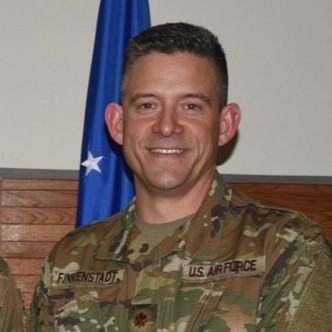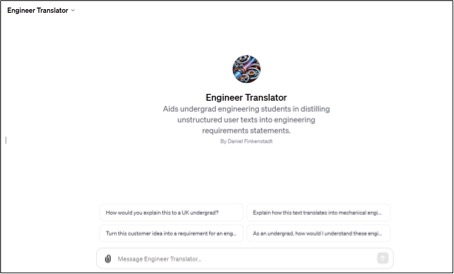“I heard you on the wireless back in ’52”: Generative AI from an educational perspective
A Guest Blog from Rajinder Bhandal and Dan Finkenstadt
Whether it is a love vs. hate relationship, generative AI, according to reality, is here to stay. In fact, it is only in its infancy, and already there is considerable progress being made from a technological perspective. Handfield (2022)argues that “AI inherently has risks and rewards, and we need to be able to understand the right applications for employing AI that balance these factors”. With that in mind, there is work being done towards learning, exploring, and deep diving into the depths of GenAI (generative AI), which includes proof-of-concept testing via real world scenarios. As an educator working in higher education, I am keen to explore the value of GenAI from an educational perspective, and it was an absolute delight for me to catch up with Dr Daniel Finkenstadt (Fink) to ponder over this subject matter.

With over 23 years of active and continued service at the US Military, Fink is a specialist in the area of federal acquisition. From a business and consulting domain, Fink is an expert in the area of business strategy, game design, curriculum development, government contracting, negotiation, to name but a few areas. As the Principal Owner of Wolf Stake Consulting LLC, Fink is leading the way in industry, showcasing the application of GenAI via use cases in the context of scenario planning, design innovations, and training. Fink was an Assistant Professor at the Naval Postgraduate School, Department of Defense Management, based in California, USA, from 2020-2023. As an author, Fink has published and co-authored insightful work including the world renowned book Supply Chain Immunity (Handfield & Finkenstadt, 2022), and recent articles published in the Harvard Business Review How Generative AI Can Augment Human Creativity (Eapen, Finkenstadt, Folk, & Venkataswamy, 2023), and Use GenAI to Improve Scenario Planning (Finkenstadt, Eapen, Sotiriadis, & Guinto, 2023). His upcoming book, Bioinspired Strategic Design co-authored with Dr. Tojin Eapen, is set to release next year.
I am excited to be able to share these narratives and unravel some of the latest thinking from our discussion. Always good to speak with you Fink, and hear first-hand about the innovative and impactful work you are engaged in. Thanks so much for your time and positive energy!
Curiosity and creativity in the classroom
Drawing on Bloom’s Taxonomy, Fink explains that curiosity and creativity plays at a much higher level of thinking. However, in some instances, individuals have barriers to reach that higher level of thinking required to promote creativity. According to Fink, GenAI tools promote learning behaviours that enrich curiosity and creativity in the classroom in the following three ways:
- DISCOVER – a way to see and experience what is going on in a specific context
- UNDERSTAND – provides a way to comprehend and make sense of the situation
- CONTROL – the ability to remove uncertainty by applying own knowledge and creativity
“The thing to understand is that curious people will interact with AI to test its limits and the process of testing, validating, enhancing prompts, and redesigning uses for the AI will all be areas for increased creativity. And those that aren’t curious are likely to see AI errors as confirmation it should be discarded or disregarded. They will be left behind”.
~ Dr Daniel Finkenstadt ~
Learn something new by learning from mistakes!
Fink highlights that it is important to learn something new, and more importantly to learn from mistakes. Building on Bloom’s Taxonomy, Fink explains that the utilisation of GenAI tools are excellent when it comes to the ‘create’ aspect of cognitive process under the taxonomy, as the process itself is creative and to create per se. Another element which GenAI hits is the ‘remember’ part of the cognitive process, and this involves training the model, and is an iterative process. Fink makes a clear distinction between the term ‘language calculator’, stating that this perception and terminology is incorrect. Thus, is not consistent with reality, as with language, it is not as simple as: 1 + 1 = 2 or 2 + 2 = 4! In other words, GenAI can be viewed as a creative assistant – let it think with you, not for you!
This aspect of learning is vital, and Fink outlines that it is important to write what you experience, in order words to document the learning from scenarios. Referring to the tools and resources available at Wolf Stake Consulting, Fink supports the use of scenarios as a methodology to enhance student learning in the classroom. More importantly, beyond education and the classroom, key skills relating to leadership, problem-solving, decision-making, and negotiation are developed. Thus, supporting employability skills in the world of work, against the backdrop of an ever-increasing digital transformation within the workplace.
GenAI promotes inclusivity and caters for different student learning styles and abilities
I shared with Fink an example from my own teaching experience, of students finding value in using GenAI. I teach the mechanical engineering students the discipline of Management. And as part of the formative assessment, I created various practice essay for the students to practice with, in addition to providing supplementary guidance.
Generally speaking, the mechanical engineering students did struggle with this task of essay writing, although for some it was not an issue. And to my surprise, the students were informing me that they were using OpenAI’s GenAI tools to help them with idea generation. This did take me by surprise, as it is still very new with regards to application in higher education institutions.
Some of my students told me that this was actually a positive learning experience, and it helped then overcome learning difficulties. I was notified that this process actually made them more confident when putting pen to paper, with their own thoughts in keeping with the teaching material. This was good preparation for the students, as the main assessment was in fact a traditional on campus exam. Arguably, GenAI, has the potential to create an inclusive student education experience.
Based on this understanding, Fink was able to showcase the value of GenAI as an educational tool by creating the following scenarios in the context of mechanical engineering students:

Image: Screenshot of “Engineer Translator” Prototype developed during our conversation. Designed to assist UK undergraduate mechanical engineering students in translating unstructured text into clear, concise engineering requirements.
Implications for assessments and providing feedback
Expanding on the above narrative, Fink discussed that it is simply not just a case of playing with GenAI or even OpenAI. It is more a matter of building them up and then playing with the tools as a source of creativity. In other words, the students can have a go at creating content generated via GenAI, and they are asked to then step back from the outputs, and then critique and edit it.
Fink explained the need to have a problem statement, in the form of a drive, needs of individuals, an issue from industry, that students can work with. The need to have a good vs. bad statement was also voiced, towards equipping the students with the right level and quality of training. Much in the same, the GenAI model itself needs to know what “right looks like” by having good and bad examples to emulate. It is important for the students to build the scenarios, various projects, and to take a reflective approach towards their own learning and discovering creative solutions.
So, did ‘video kill the radio star’?!
After all those years, did video kill the radio star? And can we apply the same thinking and sentiments to GenAI and OpenAI which is still in its infancy? What do you think?
They took the credit for your second symphony, Rewritten by machine on new technology, And now I understand the problems you can see, Oh, a, oh, I met your children, Oh a oh, What did you tell them?, Video killed the radio star, Video killed the radio star….
~ The Buggles, Video Killed the Radio Star ~


